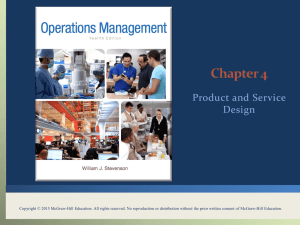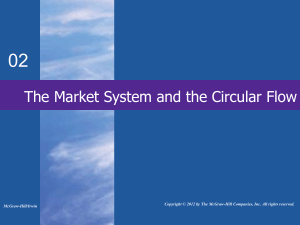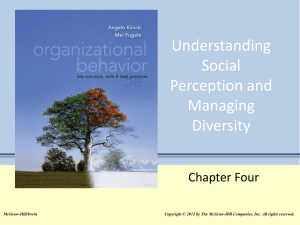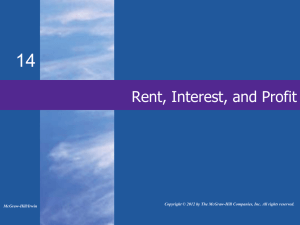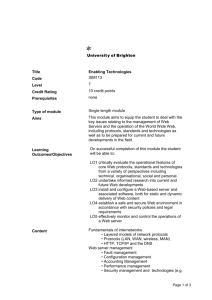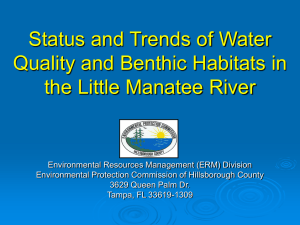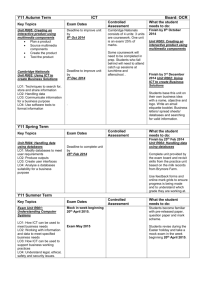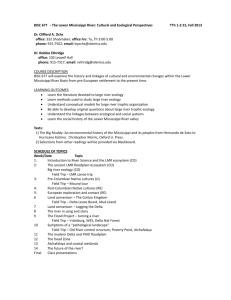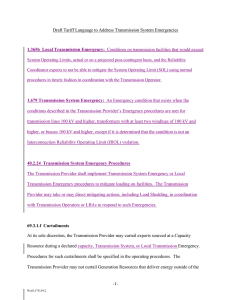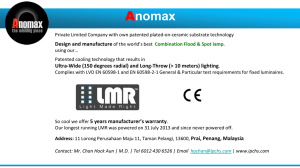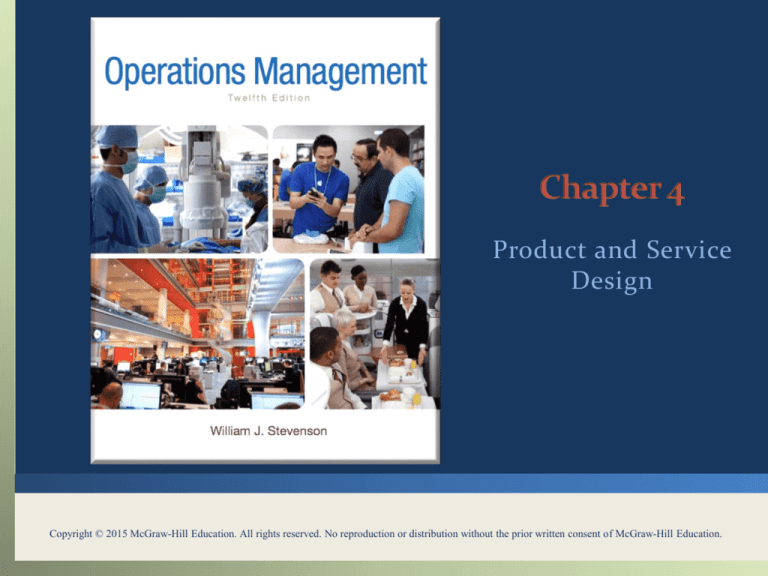
Product and Service
Design
Copyright © 2015 McGraw-Hill Education. All rights reserved. No reproduction or distribution without the prior written consent of McGraw-Hill Education.
You should be able to:
LO 4.1
LO4.2
LO4.3
LO4.4
LO4.5
LO4.6
Explain the strategic importance of product and service design
Describe what product and service design does
Name the key questions of product and service design
Identify some reasons for design or redesign
List some of the main sources of design ideas
Discuss the importance of legal, ethical, and sustainability
considerations in product and service design
LO4.7 Explain the purpose and goal of life cycle assessment
LO4.8 Explain the phrase “the 3 Rs”
LO4.9 Discuss several key issues in product or service design
LO4.10 Discuss the two key issues in service design
LO4.11 Name the phases in service design
LO4.12 List the characteristics of well-designed service systems
LO4.13 List some guidelines for successful service design
4-2
The essence of an organization is the goods and services it
offers
Every aspect of the organization is structured around
them
Product and service design – or redesign – should be
closely tied to an organization’s strategy
LO 4.1
4-3
1.
2.
3.
4.
5.
6.
7.
8.
LO 4.2
Translate customer wants and needs into product and service
requirements
Refine existing products and services
Develop new products and services
Formulate quality goals
Formulate cost targets
Construct and test prototypes
Document specifications
Translate product and service specifications into process
specifications
Involve Inter-functional Collaboration
4-4
Is there a demand for it?
1.
Market size
Demand profile
Can we do it?
2.
Manufacturability - the capability of an organization
to produce an item at an acceptable profit
Serviceability - the capability of an organization to
provide a service at an acceptable cost or profit
LO 4.3
4-5
What level of quality is appropriate?
3.
Customer expectations
Competitor quality
Fit with current offering
Does it make sense from an economic
standpoint?
4.
Liability issues, ethical considerations, sustainability
issues, costs and profits
LO 4.3
4-6
The driving forces for product and service design or
redesign are market opportunities or threats:
LO 4.4
Economic
Social and Demographic
Political, Liability, or Legal
Competitive
Cost or Availability
Technological
4-7
Supply-chain based
2. Competitor based
3. Research based
1.
LO 4.5
4-8
Ideas can come from anywhere in the supply
chain:
Customers
Suppliers
Distributors
Employees
Maintenance and repair personnel
LO 4.5
4-9
By studying how a competitor operates and its
products and services, many useful ideas can be
generated
Reverse engineering
Dismantling and inspecting a competitor’s product to
discover product improvements
LO 4.5
4-10
Research and Development (R&D)
Organized efforts to increase scientific knowledge or product
innovation
Basic research
Has the objective of advancing the state of knowledge about a
subject without any near-term expectation of commercial
applications
Applied research
Has the objective of achieving commercial applications
Development
Converts the results of applied research into useful commercial
applications.
LO 4.5
4-11
Legal Considerations
Product liability
The responsibility a manufacturer has for any injuries or
damages caused by as faulty product
Some of the concomitant costs
Litigation
Legal and insurance costs
Settlement costs
Costly product recalls
Reputation effects
Uniform Commercial Code
Under the UCC, products carry an implication of
merchantability and fitness
LO 4.6
4-12
Designers are often under pressure to
Speed up the design process
Cut costs
These pressures force trade-off decisions
What if a product has bugs?
Release the product and risk damage to your reputation
Work out the bugs and forego revenue
LO 4.6
4-13
Sustainability
Using resources in ways that do not harm ecological systems that
support human existence
Key aspects of designing for sustainability
Cradle-to-grave assessment (Life-Cycle assessment)
End-of-life programs
The 3-Rs
Reduction of costs and materials used
Re-using parts of returned products
Recycling
LO 4.6
4-14
Cradle-to-Grave Assessment
aka Life-Cycle Assessment (LCA)
The assessment of the environmental impact of a
product or service throughout its useful life
Focuses on such factors as
Global warming
Smog formation
Oxygen depletion
Solid waste generation
LCA procedures are part of the ISO 14000 environmental
management procedures
LO 4.7
4-15
Value analysis
Examination of the function of parts and materials in an effort to
reduce the cost and/or improve the performance of a product
Common questions used in value analysis
Is the item necessary; does it have value; could it be eliminated?
Are there alternative sources for the item?
Could another material, part, or service be used instead?
Can two or more parts be combined?
Can specifications be less stringent to save time or money?
Do suppliers/providers have suggestions for improvements?
Can packaging be improved or made less costly?
LO 4.8
4-16
Remanufacturing
Refurbishing used products by replacing worn-out or
defective components
Can be performed by the original manufacturer or another
company
Reasons to remanufacture:
Remanufactured products can be sold for about 50% of the cost of a
new product
The process requires mostly unskilled and semi-skilled workers
In the global market, European lawmakers are increasingly
requiring manufacturers to take back used products
Design for disassembly (DFD)
Designing a product to that used products can be easily taken apart
LO 4.8
4-17
Recycling
Recovering materials for future use
Applies to manufactured parts
Also applies to materials used during production
Why recycle?
Cost savings
Environmental concerns
Environmental regulations
Companies doing business in the EU must show that a specified
proportion of their products are recyclable
Design for recycling (DFR)
Product design that takes into account the ability to disassemble
a used product to recover the recyclable parts
LO 4.8
4-18
LO 4.9
4-19
Standardization
Extent to which there is an absence of variety in a
product, service, or process
Products are made in large quantities of identical items
Every customer or item processed receives essentially the
same service
LO 4.10
4-20
Mass customization
A strategy of producing basically standardized goods or
services, but incorporating some degree of
customization in the final product or service
Facilitating Techniques
Delayed differentiation
Modular design
LO 4.10
4-21
Delayed Differentiation
The process of producing, but not quite completing, a
product or service until customer preferences are known
It is a postponement tactic
Produce a piece of furniture, but do not stain it; the customer
chooses the stain
LO 4.10
4-22
Modular Design
A form of standardization in which component parts are grouped
into modules that are easily replaced or interchanged
Advantages
LO 4.10
easier diagnosis and remedy of failures
easier repair and replacement
simplification of manufacturing and assembly
training costs are relatively low
Disadvantages
Limited number of possible product configurations
Limited ability to repair a faulty module; the entire module must
often be scrapped
4-23
Reliability
The ability of a product, part, or system to perform its
intended function under a prescribed set of conditions
Failure
Situation in which a product, part, or system does not
perform as intended
Reliabilities are always specified with respect to certain
conditions
Normal operating conditions
The set of conditions under which an item’s reliability is specified
LO 4.10
4-24
Robust design
A design that results in products or services that can
function over a broad range of conditions
The more robust a product or service, the less likely it will fail
due to a change in the environment in which it is used or in
which it is performed
Pertains to product as well as process design
Consider the following automobiles:
Ferrari Enzo
Toyota Avalon
Which is design is more robust?
LO 4.10
4-25
Product or service design changes:
1.
Modification of an existing product or service
2. Expansion of an existing product line or service offering
3. Clone of a competitor’s product or service
4. New product or service
The degree of change affects the newness of the product or
service to the market and to the organization
Risks and benefits?
LO 4.10
4-26
Quality Function Deployment (QFD)
An approach that integrates the “voice of the customer”
into both product and service development
The purpose is to ensure that customer requirements are
factored into every aspect of the process
Listening to and understanding the customer is the central
feature of QFD
LO 4.10
4-27
LO 4.10
4-28
Basic quality
Refers to customer requirements that have only limited effect on
customer satisfaction if present, but lead to dissatisfaction if absent
Performance quality
Refers to customer requirements that generate satisfaction or
dissatisfaction in proportion to their level of functionality and
appeal
Excitement quality
Refers to a feature or attribute that was unexpected by the customer
and causes excitement
LO 4.10
4-29
LO 4.10
4-30
Concurrent engineering
Bringing engineering design and manufacturing
personnel together early in the design phase
Also may involve manufacturing, marketing and purchasing
personnel in loosely integrated cross-functional teams
Views of suppliers and customers may also be sought
The purpose is to achieve product designs that reflect
customer wants as well as manufacturing capabilities
LO 4.10
4-31
CAD
Product design using computer graphics
Advantages
LO 4.10
increases productivity of designers, 3 to 10 times
creates a database for manufacturing information and product
specifications
provides possibility of engineering and cost analysis on proposed
designs
CAD that includes finite element analysis (FEA) can significantly reduce
time to market
Enables developers to perform simulations that aid in the design,
analysis, and commercialization of new products
4-32
Designers must take into account production
capabilities
Equipment
Skills
Types of materials
Schedules
Technologies
Special abilities
LO 4.10
4-33
Manufacturability
Ease of fabrication and/or assembly
It has important implications for
Cost
Productivity
Quality
LO 4.10
4-34
When products have a high degree of similarity in features
and components, a part can be used in multiple products
Benefits:
Savings in design time
Standard training for assembly and installation
Opportunities to buy in bulk from suppliers
Commonality of parts for repair
Fewer inventory items must be handled
LO 4.10
4-35
Begins with a choice of service strategy, which
determines the nature and focus of the service, and
the target market
Key issues in service design
Degree of variation in service requirements
Degree of customer contact and involvement
LO 4.11
4-36
Products are generally tangible, services intangible
2. Services are created and delivered at the same time
3. Services cannot be inventoried
4. Services are highly visible to consumers
5. Some services have low barriers to entry and exit
6. Location is often important to service design, with convenience
as a major factor
7. Service systems range from those with little or no customer
contact to those that have a very high degree of customer
contact
8. Demand variability alternately creates waiting lines or idle
service resources
1.
LO 4.11
4-37
Characteristics
Being consistent with the organization mission
Being user-friendly
Being robust if variability is a factor
Being easy to sustain
Being cost-effective
Having value that is obvious to the customer
Having effective linkages between back- and front-of-the-house
operations
Having a single, unifying theme
Having design features and checks that will ensure service that is
reliable and of high quality
LO 4.12
4-38
1.
2.
3.
4.
5.
6.
7.
8.
9.
Define the service package in detail
Focus on the operation from the customer’s perspective
Consider the image that the service package will present both to
customers and to prospective customers
Recognize that designers’ familiarity with the system may give them
a quite different perspective than that of the customer, and take steps
to overcome this
Make sure that managers are involved and will support the design
once it is implemented
Define quality for both tangibles and intangibles
Make sure that recruitment, training, and reward policies are
consistent with service expectations
Establish procedures to handle both predictable and unpredictable
events
Establish system to monitor, maintain, and improve service
LO 4.13
4-39
Effective product and service design can help the
organization achieve competitive advantage:
Packaging products and ancillary services to increase sales
Using multiple-use platforms
Implementing tactics that will achieve the benefits of high volume
while satisfying customer needs for variety
Continually monitoring products and services for small
improvement opportunities
Reducing the time it takes to get a new or redesigned product or
service to the market
4-40

